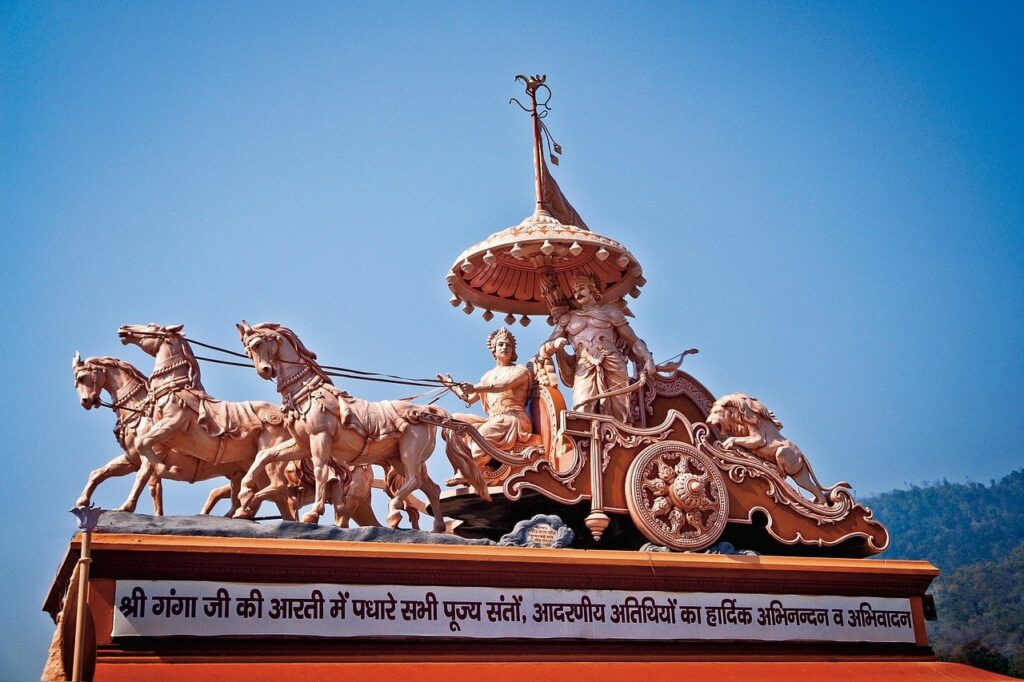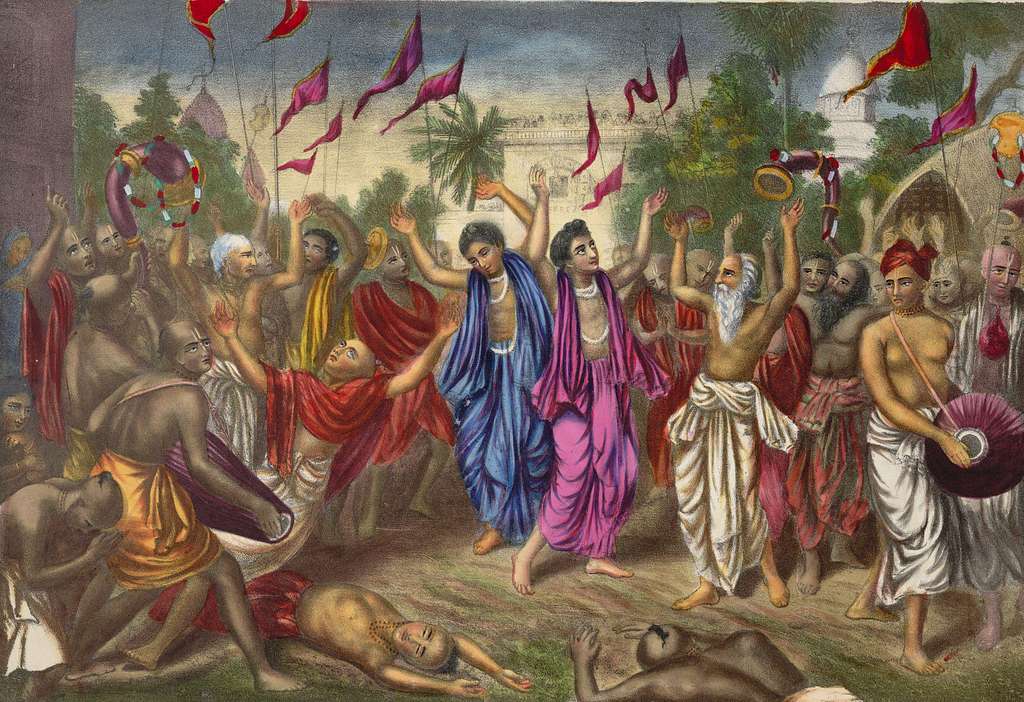
Meditation, a time-honored practice that has endured through the centuries, has recently surged in popularity as individuals worldwide seek to enhance their mental well-being and achieve a state of inner peace. This ancient technique involves channeling one’s focus and thoughts to attain a deep sense of relaxation. From Hindu and Buddhist monks to prominent figures in contemporary society, meditation has captivated the hearts of millions. In this article, we will embark on a journey to explore the diverse array of meditation techniques, including the transformative Mantra Meditation, inspired by the profound teachings of the Bhagavad Gita. We will also delve into the myriad benefits that can be harnessed by incorporating meditation into your daily routine. As elucidated in the Bhagavad Gita, meditation possesses the remarkable ability to bestow enduring advantages upon our lives. By embracing this practice, we can effectively alleviate stress, gain a profound understanding of our emotional and physical discomforts, cultivate stronger interpersonal relationships, sharpen our concentration, and foster a deep sense of self-compassion. Let us embark on this enlightening meditation guide and discover the transformative power it holds for our overall well-being.
#1 Ultimate Goal of Meditation
The Bhagavad Gita, an ancient Hindu scripture of profound wisdom, enlightens us on the path to true mastery by emphasizing the conquest of the mind. It teaches that by subduing the restless tendencies of the mind, we can attain the pinnacle of existence and experience inner tranquility. Those who achieve such serenity possess a remarkable capacity to embrace life’s diverse facets with equanimity, perceiving happiness and distress, heat and cold, honor and dishonor as fleeting phenomena. According to the Bhagavad Gita, a person who has conquered the mind regards all beings impartially, treating well-wishers, benefactors, neutrals, mediators, the envious, friends, enemies, the pious, and sinners with an equal mind.

At the heart of the Bhagavad Gita’s teachings lies the objective of meditation: to attain the divine, making the realization of God the ultimate goal of life’s journey. Through dedicated practice and detachment, by regulating the activities of the mind and body, one can transcend material aspirations and enter a state of sublime transcendence. Like a lamp undisturbed by the wind, the mind of a transcendentalist who has achieved control remains steady in meditation on God, entering a state of samadhi. In this elevated state, pure joy is experienced, and the self is relished and rejoiced in, allowing for the attainment of boundless transcendental happiness through the senses beyond the material realm.
Such an individual becomes firmly established in truth and remains unshaken, even amidst the greatest adversities. This state of being represents true liberation from the miseries that arise from material entanglements, serving as the ultimate goal of meditation, as expounded in the Bhagavad Gita (6.20-23). It is an extraordinary state of freedom, where one is united with the divine and transcends the limitations of mundane existence, finding solace in eternal bliss.
#2 Dhyana (Meditation) – as explained by Krishna to Arjuna in Bhagavad Gita
In the Bhagavad Gita (6.11-15), it is emphasized that for successful meditation, the yogi must find a secluded and tranquil place to sit, laying kusa grass or a soft cloth as a base. The seat should be situated in a sacred location, not too high or low, and the practitioner should focus on purifying their heart by controlling their mind, senses, and activities, and concentrating on God, making Him the ultimate goal of Life (manah samyamya mac-citto). By regulating their eating, sleeping, recreation, and work habits, one can mitigate all material pains through meditation. As a person disciplines their mental activities and becomes established in transcendence, they become well-versed in yoga, devoid of all material desires. To achieve success, one must engage with determination and faith, abandon all material desires, and control all senses by the mind. Gradually, step by step, one should become situated in trance by means of intelligence sustained by full conviction and fixed on the Self alone. By withdrawing the mind from its unsteady nature and bringing it back under the control of the Self, one can attain the highest perfection of transcendental happiness, beyond the mode of passion and freed from all reactions to past deeds. A true yogi observes God in all beings and sees every being in God, never separating from God and realizing their qualitative identity with the Supreme.

#2.1 Verdict of Arjuna
When Krishna expounded upon the above process of meditation to Arjuna, doubts and concerns emerged within the warrior’s mind regarding the practicality and endurance of such a profound system. Arjuna, recognizing the restless, potent, and obstinate nature of the mind, drew a poignant analogy, likening it to the formidable challenge of taming the wind itself. It is worth noting that Arjuna was no ordinary individual; he was a highly skilled warrior, proficient in the mastery of mystic weapons. This conversation between Krishna and Arjuna unfolded during the epoch of Dvapara Yuga, an era characterized by people possessing more robust bodies and minds than those of us living in the current Kali Yuga.

Considering Arjuna’s reservations in the face of these techniques, it becomes evident that if they appeared challenging to someone of his stature, they would undoubtedly present even greater hurdles for us in our modern age. The stark contrast between the strengths of individuals in Dvapara Yuga and our present circumstances reminds us of the potential difficulties we may encounter on our own paths of meditation.
#2.2 Dhyana – A limb of Ashtanga Yoga
The eight limbs of Ashtanga Yoga are as follows –
- yama – do’s and the don’ts
- niyama – developing virtues
- asana – physical postures
- pranayama – breathing exercises
- pratyahara – sense withdrawal
- dharana – concentration
- dhyana – meditation
- samadhi – trance (absorption of the mind on one point)
The contemporary form of Hatha Yoga that has gained popularity today is closely connected to the “asana” stage of ashtanga yoga. While the physical exercises within Ashtanga Yoga undoubtedly promote physical well-being, their primary purpose extends beyond mere bodily health. Instead, they serve as catalysts for introspection and self-realization. Patanjali’s teachings caution practitioners not to be swayed by the allure of mystical siddhis or perfections but to remain focused on the ultimate goal of self-realization.
This transformative process involves discerning the distinction between matter and spirit, purging oneself of base qualities such as lust, greed, and illusion, and attaining absolute mastery over the mind and senses. The term “kaivalya” refers to the profound realization that one’s true identity lies not in the physical body but in the eternal soul within. This state of self-realization is achieved when the yogi establishes unwavering concentration in meditation on the divine presence residing within the heart, emancipating themselves from the influence of the three modes of material nature. Through diligent practice and unwavering devotion, the practitioner of Patanjali’s system can traverse the path of self-discovery, unlocking the sublime realization of their true essence and experiencing profound liberation from the constraints of material existence.
#3 A Comparison of Ashtanga Yoga and Bhakti Yoga: Paths to Peace and Fulfillment
yamadaibhir yoga pathaih
kama-lobha hato muhuh
mukunda-sevaya yadvat
tathatmaddha na samyati
(Srimad Bhagavatam, 1.6.35)
–
While it is indeed true that the practice of restraining the senses through the yoga system can provide temporary relief from the disturbances caused by desires and lust, it alone cannot fully satisfy the yearnings of the soul. True satisfaction of the soul is derived from engaging in devotional service to the Supreme Lord.
The process of Ashtanga Yoga, consisting of Yama, Niyama, asana, Pranayama, pratyahara, dhyana, Dharana, and samadhi, holds the potential to bring peace to those who diligently practice it. However, it is important to recognize that in certain circumstances, practitioners may find themselves overwhelmed by lust and greed, leading them to indulge in the pursuit of transient intermediary results. Instead of steadfastly pursuing the ultimate goal of attaining inner peace, they may become derailed from their yogic practice.
In contrast, the path of Bhakti Yoga, the practice of loving devotional service unto the Supreme Lord, is free from such impediments. Devotees engaged in rendering devotional service do not seek or receive any intermediary outcomes. Their focus remains unwaveringly fixed on the Supreme Lord, ensuring that their pursuit is not diverted or hindered by temporary distractions. Thus, a sincere servant of the Lord unquestionably attains the desired state of peace and fulfillment.

Both the practice of Ashtanga Yoga and Bhakti Yoga share the ultimate objective of realizing Bhagavan, the Supreme Personality of Godhead, who is the revered object of worship for all living beings. The deliverance sought through yogic practice aligns with the love of God attained through the cultivation of Bhakti Yoga. Consequently, the ultimate aim of these two paths is identical. This is exemplified by the Vedic scriptures, which often describe the great devotee Sukadeva Goswami as a Maha-yogi, while the esteemed Yogi Lord Shiva is frequently depicted as a devoted servant of the Supreme Lord.
The principal distinction between Ashtanga Yoga and Bhakti Yoga lies in the process and timeline of achieving their respective goals. By strictly practicing Yoga, one may attain samadhi and realize their constitutional position, ultimately awakening Prema, pure love of God. However, this journey through the process of Ashtanga Yoga requires considerable time and carries the risk of becoming bewildered and sidetracked by trivial by-products before attaining perfection.
On the other hand, the path of devotional service, Bhakti Yoga, focuses solely on cultivating Prema, pure love of God. It is the science of nurturing this divine love. When all aspects of the process are directed towards the ultimate result, there is no fear of being entangled by insignificant interim achievements. The means themselves become the end, and the end becomes the means. Therefore, the path of devotional service is simpler in comparison to Ashtanga Yoga and is accessible to all seekers of spiritual growth. That is why Krishna concludes by stating the following –
yoginam api sarvesam
mad-gatenantar-atmana
sraddhavan bhajate yo mam
sa me yuktatamo matah
(Bhagavad Gita 6.47)
–
And of all yogis, he who always abides in Me (Krishna) with great faith, worshiping Me in transcendental loving service (bhakti), is most intimately united with Me in yoga and is the highest of all. That is My opinion.
#4 Mantra Meditation – Kirtaniya Sada Hari
In the current age of Kali, characterized by violence, deception, and spiritual decline, adhering to the stringent rules of traditional meditation may seem unattainable. The prescribed regulations of finding a sacred place, focusing solely on the Supersoul, restraining the senses and mind, practicing celibacy, and seeking solitude have become increasingly challenging to uphold. In this context, one may wonder what practice can enable mind control and spiritual progress in Kali Yuga. According to the Brhan Naradiya Purana, the sole means of salvation in this era is the repetition of the holy names of Lord Hari. Within the practice of Bhakti Yoga, the nine limbs begin with sravanam (hearing) and Kirtanam (chanting). The Kali Santarana Upanishad also affirms the extraordinary power of the ‘Hare Krishna Mahamantra’ in dispelling all inauspiciousness associated with Kali Yuga. Amidst the prevalent discord and hypocrisy of this age, the path to enlightenment has become more accessible, and chanting the holy names of the Lord stands as the key to transcendence.
harer-nama harer-nama harer-namaiva kevalam
kalau nasty-eva nasty-eva nasty-eva gatir anyatha
(Brhan Naradiya Purana)
–
In this age of Kali the only means of deliverance is chanting of the holy name of Lord Hari. There is no other way. There is no other way. There is no other way.
Hare krsna hare krsna krsna krsna hare hare
Hare rama hare rama rama rama hare hare
Iti sodasakam namnam kali kalmasa nasanam
Natah parataropayah sarva vedesu drsyate
(Kali Santarana Upanishad)
–
The sixteen syllables of the Hare Krishna Mahamantra: ‘Hare Krishna Hare Krishna Krishna Krishna Hare Hare, Hare Rama Hare Rama Rama Rama Hare Hare’ destroy all inauspiciousness in this age of Kali. This is the verdict of the Vedas.
By chanting the holy name of Lord Krishna (Hari), which is infused with His divine potency, one can embark on a transformative journey of spiritual progress. This sacred name is inseparable from the Lord Himself, and through its continuous repetition, one can establish a profound connection with Him. Known as ‘Mantra Meditation,’ this practice serves as a potent means of purifying the mind, eliminating doubts, and dispelling negative thoughts. As individuals immerse themselves in the vibrations of the divine name, they gradually attain enlightenment and become detached from worldly distractions that hinder their focus on the Lord. By detaching the mind from worldly activities and engaging it in spiritual pursuits, one can easily attain ‘Vairagya’, or detachment from materialism.

Kaler dosa nidhe rajann asti hy eko mahan gunah
Kirtanad eva krsnasya mukta sangha param vrajet
(Srimad Bhagavatam, 12.3.51)
–
My dear King, although Kali Yuga is an ocean of faults, yet there is one good quality about this age: Simply by chanting the holy names of Krishna, one gets liberated from material bondage and is promoted to the transcendental spiritual kingdom.
#4.1 Awakening Higher Happiness: The Power of Chanting the Hare Krishna Mahamantra
Chanting the holy name of Lord Krishna holds immense potency in the process of mind control. The name is not a mere sound but a manifestation of the Lord’s divine presence. By consistently and attentively chanting this sacred mantra, individuals open themselves to the all-encompassing influence of the Lord’s grace. The vibrations of the holy name penetrate deep into the recesses of the mind, purging it of doubts, anxieties, and negative tendencies. As one progressively absorbs themselves in the vibrations of the divine name, the mind becomes purified, attaining clarity and tranquility.
The allure of the mind, constantly tempting us towards lesser pleasures, can be countered effectively through the power of the evocative mantra. By channeling our focus towards the Hare Krishna mahamantra, we tap into the reservoir of higher happiness. The resounding vibrations of the mantra resonate within our consciousness, quieting the noise of the mind and connecting us to the supreme source of joy – Krishna. In this way, we fortify ourselves against the grip of the provocative mind, embracing the transformative influence of the evocative mantra to access sublime happiness.

Within each one of us, there exists an eternal and unbreakable bond of love with Krishna, the Supreme Personality of Godhead. This divine relationship can be nurtured and strengthened through the regular chanting of the Hare Krishna Mahamantra. Just as the remembrance of a beloved person fills our hearts with joy, the recollection of our supreme beloved, Krishna, awakens the highest levels of bliss within us. By directing our thoughts towards Krishna and repeating the sacred Hare Krishna Mahamantra, we invite the divine presence of love into our lives, nourishing our hearts with supreme joy and fulfillment. Love, in its most profound expression, flourishes through acts of dedicated service. The Hare Krishna Mahamantra, being a sonic manifestation of Krishna Himself, provides a unique opportunity for us to engage in His service through attentive hearing. Immersed in the transcendental vibrations of this sacred sound, we actively participate in the loving service of Krishna. Through this heartfelt service, our love for Him deepens and intensifies, elevating our experience of higher happiness and bringing tranquility to the restless mind.
#4.2 How to practice Mantra Meditation?
The Hare Krishna Maha Mantra is a divine gift from the spiritual realm, as understood from the statement “Golokera prema dhana harinama sankirtana.” This sacred practice of chanting the Hare Krishna mantra transcends all levels of consciousness, including the sensual, mental, and intellectual realms. It operates on a spiritual platform, making it unnecessary to comprehend the mantra’s language or engage in mental speculation or intellectual analysis. The chanting of this powerful mantra is automatic and accessible to all, regardless of their qualifications or prior knowledge. When chanting the Hare Krishna Mahamantra, there is no requirement to consider the factors of time, place, or circumstance.
To properly honor the holy name of Krishna, one must chant with proper devotion and understanding of its potency. The power of the holy name remains concealed when there is any doubt or uncertainty regarding its efficacy. Only those who have faith in the holy name of Sri Krishna can experience its divine grace, as it is an enigmatic mystery accessible only to the faithful. Devotees should strive to deepen their understanding of this sacred truth.

There exist two forms of mantra meditation known as Japa and Kirtan. Japa involves a tranquil and individual practice where one recites chants using prayer beads (described below). On the other hand, Kirtan is a lively communal meditation that revolves around the same sound vibration. It follows a call-and-response format and incorporates vibrant musical instruments. Below, we have provided a comprehensive description of how to effectively chant the Hare Krishna Mahamantra using prayer beads (japa).
One should chant the following Hare Krishna Mahamantra preferrably on Tulasi beads –
Hare Krishna Hare Krishna Krishna Krishna Hare Hare, Hare Rama Hare Rama Rama Rama Hare Hare
The Kali Santarana Upanishad declares the Hare Krishna Mahamantra as the destroyer of all inauspiciousness (iti sodasakam namnam kali kalmasa nashanam). Sri Chaitanya Mahaprabhu, the incarnation of the Supreme Lord, urges us to chant the holy name of Krishna incessantly and also to spread the message of the glory of chanting to others (yare dekho taare kaha Krishna upadesha…). It is imperative that we take refuge in Sri Chaitanya Mahaprabhu and His associates before commencing each round of the Hare Krishna Mahamantra. To do so, we must first chant the Pancha Tattva Maha Mantra.
‘Jaya Sri Krishna Chaitanya, Prabhu Nityananda ,Sri Advaita, Gadadhara, Srivasa adi Gaura bhakta vrinda’
–
Translation – I offer my respectful obeisances unto Sri Chaitanya Mahaprabhu, Lord Nityananda, Sri Advaita, Gadadhara Pandit, Srivasa Thakura and all the devotees of Lord Chaitanya.
Chanting the holy names of Sri Chaitanya Mahaprabhu and His associates bestows upon us their causeless mercy enabling us to chant Krishna’s names without committing any offenses.
One complete cycle of chanting on a string of 108 beads is called a round, and it is recommended to chant the entire Hare Krishna Mahamantra on each bead before moving on to the next one. To reap the maximum benefits, it is advised to chant a minimum of 16 rounds of the Hare Krishna Mahamantra daily in the present era. However, beginners can start with a smaller number of rounds and gradually increase the count over time. Before beginning each round of the Hare Krishna Mahamantra, it is crucial to chant the Pancha Tattva Mantra at least once.
#4.3 Meaning of Hare Krishna Mahamantra
The transcendental name of Hari, much like fire that burns an object upon contact, has the power to eradicate or “burn up” all the sins of those who are caught up in materialistic pursuits. This divine name not only removes ignorance but also reveals the blissful form of the Lord. Hari, as a term, refers to an enchanting personality whose divine qualities captivate the minds of all beings in the universe. His youthful, beautiful form is so attractive that even the Cupids are mesmerized by it. The term “Hare” is the vocative form of Hari.
In addition to its other meanings, the term “Hare” can also refer to Hara or Srimati Radhika, the daughter of Vrishabhanu. She is known for stealing the mind of Hari during the rasa dance with her beautiful form and loving affection. The term “Hare” is the vocative form of Hara.
The term “Krishna” is derived from the root “Krs,” which means “all-attractive,” and “na,” which refers to “supreme bliss.” When combined, they form the word “Krishna,” which represents the all-attractive and supremely blissful Supreme Personality of Godhead, Sri Krishna. He is also known as Nandanandana and Sri Govinda, with lotus-like eyes and a dark blue complexion. For the Vrajavasis, Krishna is the sole source of bliss.
The term “Rama” implies “ramante,” meaning the embodiment of unlimited pleasure. Sri Krishna, who is highly skilled in loving affairs and is worshiped for His amorous pastimes, always takes pleasure in the company of Radha. This is why He is referred to as Rama (Radharamana Rama).
The supreme brahman is also recognized as ‘Rama’, as yogis find joy in contemplating His eternal, blissful form.
Hare Krishna Hare Krishna Krishna Krishna Hare Hare
Hare Rama Hare Rama Rama Rama Hare Hare
O Radha, please draw my mind towards you and release me from the material world.
O Krishna, please attract my mind to you.
O Radha, captivate my heart with your sweetness.
O Krishna, purify my mind by imparting the knowledge of how to worship you through your pure devotee.
O Krishna, grant me the firmness to appreciate your name, qualities, and pastimes.
O Krishna, may I develop a taste for serving you.
O Radha, make me eligible to serve you.
O Radha, teach me how I can serve you.
O Radha, let me hear about your intimate pastimes with your beloved.
O Rama (Krishna), let me hear about your intimate pastimes with your beloved.
O Radha, reveal your pastimes with your beloved to me.
O Rama, reveal your pastimes with your beloved to me.
O Rama, engage me in remembering your name, form, qualities, and pastimes.
O Rama, make me eligible to serve you.
O Radha, be pleased with me.
O Radha, be pleased with me.
A Poem on Mantra Meditation
In the age of Kali’s strife and despair,
Where violence and deceit permeate the air,
Where spirituality wanes, its light grows dim,
A quest for solace, a yearning within.
Traditional meditation, stringent and pure,
Seems unattainable, out of reach for sure.
Sacred places, senses restrained,
Celibacy, solitude, principles ingrained.
But fear not, seekers of truth profound,
For a practice exists, a solution is found.
The Brhan Naradiya Purana speaks,
Of a salvation method, the soul it seeks.
Chanting the holy names, a divine decree,
The repetition of Hari’s melody.
No need for language or mental strain,
No intellectual puzzles to explain.
A path that’s open, accessible to all,
The Kali Santarana Upanishad’s call,
The Hare Krishna Mahamantra, a mighty key,
To dispel the darkness and set the soul free.
For the sixteen syllables hold a profound might,
Hare Krishna Mahamantra shining so bright,
In Kali Yuga’s discord and hypocrisy’s reign,
The path to transcendence, the sacred refrain.
With each uttered word, a connection is made,
To the Lord Himself, the soul’s eternal aid.
Mantra Meditation, purifying the mind,
Banishing doubts, leaving worries behind.
An unbreakable bond, eternal and true,
With Krishna, the Supreme, residing in you.
Through chanting, remembrance takes flight,
Love awakened, filling hearts with delight.
In service we thrive, a devotion so pure,
The Hare Krishna Mahamantra, a love-filled lure.
Engaged in His service, our love grows strong,
Higher happiness found, a tranquil throng.
So, in the depths of Kali’s turbulent sea,
The Hare Krishna Mahamantra sets us free.
A melody of hope, a beacon so bright,
Guiding us toward bliss, in love’s sacred light.
